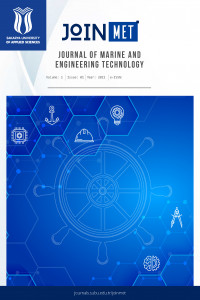Research Article
Year 2021,
Volume: 1 Issue: 1, 42 - 47, 30.06.2021
Abstract
In this study, we examined the sea transportation, which is an important type of transportation, and the emergencies seen in this transportation. Fire, explosion, water intake (sinking), unwanted reaction of dangerous chemicals carried, situations that may endanger the lives of the personnel and passengers on board are among the emergencies encountered at sea. The design and structural features of ship doors, which have an important place in shipbuilding, were examined. In addition, the role of ship doors in preventing emergencies has been examined, taking into account the emergencies experienced in ships sailing in ports or at sea.
Keywords
References
- [1] Lionel, Casson, Ships and Seafarin in Ancient Times, London, British Museum Press, 2002.
- [2] Camcı, Bayram, Zafer Cezmi, “Türk Deniz Ticareti ve Türkiye Denizcilik İşletmeleri Tarihçesi” İstanbul, Kültür Yayınları, 1994.
- [3] Aktaran, Deniz Ticareti Dergisi, Sayı: Şubat 2017, s.3, İMEAK Deniz Ticaret Odası Resmi Yayını.
- [4] Elbirlik, G. Türk Lojistik Sektöründe Denizyolu Taşımacılığının Önemi ve Sorunları. Dokuz Eylül Üniversitesi Sosyal Bilimler Enstitüsü. (Yüksek Lisans Tezi). İzmir. 2008.
- [5] Cheng, X., & Miao, Y.” Discussion on Preventing and Controlling Emergency Situation on Board.” In 2009 First International Conference on Information Science and Engineering 29162919. IEEE. 2009.
- [6] Wang, J. “Maritime Risk Assessment and Its Current Status. Quality and Reliability Engineering International”, 22(1), 3-19. 2006.
- [7] IMO 2016 safety of life at sea, consolidated edition 20019, International Maritime Organization
- [8] Ömer Soner, Umut Aslan, Metin Çelik, “Use of HFACS–FCM in fire prevention modelling on board ships” Safety Science 77, 25-41, 2015.
- [9] E. Akyüz, “A marine accident analysing model to evaluate potential operational causes in cargo ships” Safety Science, 92, Pages 17-25, 2017.
- [10] Wu, B., Zong, L., Yip, T. L., & Wang, Y. (A probabilistic model for fatality estimation of ship fire accidents. Ocean Engineering, 17, 2018.
- [11] IMO 2009 safety of life at sea, consolidated edition 2009, International Maritime Organization,
- [12] https://www.chemfleet.org/, (Erişim: 29.05.2021 saat: 14.20)
- [13] Clarksons Research, Shipping Intelligence Network. Available from: http://www.clarksons.net, 2017.
- [14] http://www.dieselduck.info/machine/04%20auxiliary/watertight/watertigth.htm (Erişim: 29.05.2021 saat: 15.20)
- [15] Yusuf ZORBA, Uluslararası Deniz Ticaretinde Tehlikeli Yüklere İliskin Güvenlik Yönetimi: Uluslararası Denizde Tehlikeli yük Tasımacılığı Standartları (IMDG CODE) ve Türkiye uygulamaları , Dokuz Eylül Üniversitesi, Sosyal Bilimler Enstitü
Year 2021,
Volume: 1 Issue: 1, 42 - 47, 30.06.2021
Abstract
References
- [1] Lionel, Casson, Ships and Seafarin in Ancient Times, London, British Museum Press, 2002.
- [2] Camcı, Bayram, Zafer Cezmi, “Türk Deniz Ticareti ve Türkiye Denizcilik İşletmeleri Tarihçesi” İstanbul, Kültür Yayınları, 1994.
- [3] Aktaran, Deniz Ticareti Dergisi, Sayı: Şubat 2017, s.3, İMEAK Deniz Ticaret Odası Resmi Yayını.
- [4] Elbirlik, G. Türk Lojistik Sektöründe Denizyolu Taşımacılığının Önemi ve Sorunları. Dokuz Eylül Üniversitesi Sosyal Bilimler Enstitüsü. (Yüksek Lisans Tezi). İzmir. 2008.
- [5] Cheng, X., & Miao, Y.” Discussion on Preventing and Controlling Emergency Situation on Board.” In 2009 First International Conference on Information Science and Engineering 29162919. IEEE. 2009.
- [6] Wang, J. “Maritime Risk Assessment and Its Current Status. Quality and Reliability Engineering International”, 22(1), 3-19. 2006.
- [7] IMO 2016 safety of life at sea, consolidated edition 20019, International Maritime Organization
- [8] Ömer Soner, Umut Aslan, Metin Çelik, “Use of HFACS–FCM in fire prevention modelling on board ships” Safety Science 77, 25-41, 2015.
- [9] E. Akyüz, “A marine accident analysing model to evaluate potential operational causes in cargo ships” Safety Science, 92, Pages 17-25, 2017.
- [10] Wu, B., Zong, L., Yip, T. L., & Wang, Y. (A probabilistic model for fatality estimation of ship fire accidents. Ocean Engineering, 17, 2018.
- [11] IMO 2009 safety of life at sea, consolidated edition 2009, International Maritime Organization,
- [12] https://www.chemfleet.org/, (Erişim: 29.05.2021 saat: 14.20)
- [13] Clarksons Research, Shipping Intelligence Network. Available from: http://www.clarksons.net, 2017.
- [14] http://www.dieselduck.info/machine/04%20auxiliary/watertight/watertigth.htm (Erişim: 29.05.2021 saat: 15.20)
- [15] Yusuf ZORBA, Uluslararası Deniz Ticaretinde Tehlikeli Yüklere İliskin Güvenlik Yönetimi: Uluslararası Denizde Tehlikeli yük Tasımacılığı Standartları (IMDG CODE) ve Türkiye uygulamaları , Dokuz Eylül Üniversitesi, Sosyal Bilimler Enstitü
There are 15 citations in total.
Details
| Primary Language | Turkish |
|---|---|
| Subjects | Maritime Engineering |
| Journal Section | Research Articles |
| Authors | |
| Publication Date | June 30, 2021 |
| Submission Date | June 6, 2021 |
| Published in Issue | Year 2021 Volume: 1 Issue: 1 |


